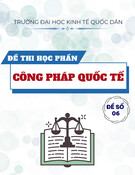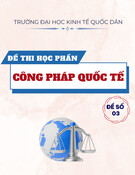
ARTICLE
Diffusion of Geographical Indication Law in Vietnam:
“Journey To The West”
Sy Luong Nguyen ·Van Anh Le
Accepted: 30 January 2023 / Published online: 15 February 2023
©The Author(s) 2023
Abstract For a long time, Vietnamese legislators and scholars did not discuss
geographical indication (GI) law in depth despite its having been long established in
the country. However, when Vietnam signed the EU-Vietnam Free Trade Agree-
ment (EVFTA) in 2020, the tide turned: GIs now have a “VIP seat” in the treaty
text. Without debating whether GIs have boosted local agriculture, this article
discovers how and why the law has been transposed into Vietnamese law. To this
end, we first accept Watson and Twining’s theories to presuppose legal transplant.
Then, we employ five models surveyed by Morin and Gold to appraise how law-
makers adopt rules that might not always benefit the adopting country. We conclude
that the EVFTA is a key influencer in disseminating the relevant policy, but that
enforcement is far from successful.
Keywords Vietnam · Geographical indication · Diffusion of law · EVFTA
1 Introduction
Like Peppa Pig for British children, “Journey to the West” (or Tây Du Kí in
Vietnamese) formed part of many Vietnamese childhoods. This Chinese folktale
follows Buddhist monk Xuanzang on a pilgrimage he made to India with four
disciples on a search for holy books. They survived 81 adventures before returning
to China with sacred scriptures. Like monk Xuanzang, Vietnam “travelled” to the
S. L. Nguyen
LLM; Lecturer in IP Law, University of Law, Hue University, Hue, Vietnam
e-mail: nguyenluongsy@hueuni.edu.vn
V. A. Le (&)
PhD; Departmental Lecturer in IP Law, Faculty of Law, University of Oxford, Oxford, UK
e-mail: van-anh.le@law.ox.ac.uk
123
IIC (2023) 54:176–199
https://doi.org/10.1007/s40319-023-01289-9

West to learn how to protect agricultural products through geographical indications
(GIs) – a Western-invented concept. Similarly, its legal voyage faced no fewer
hurdles.
A GI is a product label, but a powerful one. It extends beyond the ordinary
commercial label that gives basic information about a product: it unveils the
product’s geographical origin as well as the quality or reputation owing to that area.
GI labels, such as Darjeeling tea, Parma ham, Scotch whisky, Champagne, and
Cuban cigars, equate to a certificate that guarantees a product’s authenticity and
uniqueness. A GI label can persuade consumers to dip deep into their pockets. Not
just that, a GI empowers its holder to prohibit other traders from misusing or
imitating the product, reducing consumer search costs where product visuals might
not appear different.
While many GIs are available worldwide, the European Union (EU) and the
United States (US) are the largest markets,
1
each making significant profits from
selling GI-protected commodities. Meanwhile, Vietnam gets little from GIs despite
its famous gastronomy, an agricultural sector that forms the backbone of the
economy, and the fact that the whole land is saturated with plantations of banana,
coconut, and citrus trees, coffee and black peppers. While some studies have
diagnosed why the country has failed to make the most of the GI scheme,
2
little is
known about how and why the law has been brought into the region. With the first
clue of diffusion of law, we uncover the mystery.
1.1 A Synopsis of the Diffusion of IP Law
Diffusion of law, defined by William Twining, refers to a process in which one legal
order, system, or tradition influences another in some significant way.
3
His theory is
entwined with the concept of “legal transplant”, a term first coined by Alan Watson,
which was later embraced by many scholars and anchored in comparative law.
4
Legal transplant, a “conceptual tool”,
5
describes the movement of laws from one
country to another with no prior link between these laws (transplants) and society.
6
Although Watson addressed “diffusion of law” in the second edition of his book,
7
Twining has made himself known for advancing the diffusionism-based theory.
8
1
Giovannucci et al. (2009), p. 11.
2
Pick et al. (2017), pp. 305–332; Pick (2018); Hoang and Nguyen (2019), pp. 513–522; Durand and
Fournier (2017), pp. 93–104.
3
Twining (2004), p. 14.
4
Watson (1974).
5
Goldbach (2019), p. 583.
6
Watson (1974).
7
“The concept of ‘legal transplant’ has a naturalistic ring to it as though it occurs independent of any
human agency. In point of fact, however, elites – legal and nonlegal – often act as ‘culture carriers’ or
intermediaries between societies involved in a legal transplant. […] Hence, it is a misnomer to describe
and analyse the diffusion of law [emphasis added] as if it were devoid of human agency.” Watson (1993),
p. 114.
8
Twining (2000), p. 144, where he mentioned that his view on the legal elites as the main receivers of
law is only a moderated version of Watson’s famous transplant thesis.
Diffusion of Geographical Indication Law in Vietnam… 177
123

Nevertheless, there is a caveat. Neither Watson nor Twining’s works gravitate
towards specific geographical or legal areas.
In intellectual property (IP), law propagation happens in three phases. First, a
handful of European powers transplanted IP systems onto their colonies’ soil via
colonial rules. For example, the British based the first Indian patent law (Act VI of
1856) on the British Patent Law Amendment Act of 1852. In 1809, the Portuguese
Crown passed the first patent statute in Brazil. In 1893, the French applied its
Patents Act of 1844 to the Indochinese colonies, including Cambodia, Laos, and
Annam (Vietnam). The colonists did not pass those rules for the benefit of the locals
but in order to transfer colonial capital through commercial monopolies.
9
Then, the same European countries and the US sought to protect each other’s IP
rights under national law and to treat foreign and local right holders equally. To that
end, they formed the Paris Convention for the Protection of Industrial Property
(1883) and the Berne Convention for the Protection of Literary and Artistic Works
(1886). This (second) phase witnessed those countries harmonising disparate IP
norms. The colonies found themselves in those “IP clubs” without being asked,
since the colonisers signed up on their behalf.
10
As the adage goes, “the rich get
richer”: those Conventions amplify the power of the strong and the wealth of the
rich.
Because the Paris and Berne Conventions did not have a system to ensure that
rules were followed, the same group of countries were dissatisfied and cast around
for another forum. They came up with the TRIPS Agreement, marking the third
phase of law propagation. Global harmonisation, which had been germinated by
Paris and Berne, culminated in TRIPS. Following TRIPS, IP rights mushroomed
across the world.
But legal transplanting does not end there. The world has entered a new phase
where the “new generation” of Free Trade Agreements (FTAs), with more rigid
standards than required by TRIPS required, is blooming. Through those FTAs,
developed countries (IP exporters) ship their IP models to developing countries (IP
importers).
1.2 A Synopsis of Vietnam’s GI Law
Mapping the epoch onto Vietnam’s historical path, its IP journey began in the
nineteenth century, when the French first set foot in the region. Not only did they
bring with them coffee and baguettes (which the locals eventually transformed into
outstanding cuisine), but they also injected French IP systems of copyright, patents,
and trade marks.
11
Nevertheless, GIs, a derivative form of trade mark that originated
in France in the late 1800s, were not transferred so early on.
12
However, as we shall
9
See Okediji (2003), p. 315 for more discussion on the historical relationship between international law,
IP rights and the developing world.
10
See Upreti (2022), p. 220 for more discussion on third-world approaches to international law.
11
Kien (2017), p. 539; Kien (2021), p. 122; Le (2022), p. 1048.
12
Calboli (2017), p. 10.
178 S. L. Nguyen, V. A. Le
123

see, the French played an influential role in bringing the GI legal framework to
Vietnam and in building the country’s registration system.
Although Vietnam has been a member of the Paris Convention – the first
international agreement regulating GIs – since 1949, the government only enacted a
GI-like scheme in 1989 through the Ordinance on the Protection of Industrial
Property Rights. However, this scheme remained in hibernation until 2001, when
the first two GI products – Phu Quoc Fish sauce and Shan Tuyet tea from Moc Chau
– were registered. Paradoxically, the registration would have been impossible had it
not been for technical assistance received from France.
13
Since then, Vietnam’s GI applications have been few and far between (See
Fig. 1). Once a peripheral topic on Vietnamese policymakers’ radar, GIs came to the
forefront when the EU-Vietnam Free Trade Agreement (EVFTA) entered into force
in August 2020. The EU is the most vocal proponent of GI protection because of the
economic value originating from its GI products. For example, the EU’s total sales
of GI products in 2017 were estimated at 74.8 billion euros, of which wines
accounted for 51%.
14
As a result, GIs carry enormous weight in EU trade talks. The
EU would not action any FTA unless an “appropriate” chapter on GIs were
included.
15
A specific GI section is a “must-have”.
16
For this reason, the EVFTA differs from other FTAs in which Vietnam has
participated, such as the CPTPP (Comprehensive and Progressive Agreement for
Trans-Pacific Partnership)
17
or the RCEP (Regional Comprehensive Economic
Partnership)
18
because of its explicit commitments on GIs. The EVFTA contains an
annex that lists the GIs to be protected in the partner countries as part of the trade
deal. Even the Working Group’s name reflects this particular interest of the EU:
“Working Group on Intellectual Property Rights, including Geographical
Indications”.
19
This paper focuses on the EVFTA as a case study of legal transplantation
between two distinct legal systems: the EU and Vietnam. The former is a political
and economic union of 27 European Member States. Since the Maastricht Treaty,
the EU has claimed to be not only an economic community but also a community of
values founded inter alia on democracy. Vietnam, on the other hand, is a socialist
country with a political system based on Marxist-Leninist ideology,
20
the
13
Vu and Dao (2006).
14
European Commission (2021).
15
Dao (2016), p. 12.
16
Huysmans (2022), pp. 979–983; Giovannucci et al. (2009), p. 63.
17
The CPTPP was signed on 8 March 2018, having emerged from the Trans-Pacific Partnership (TPP),
which never came into effect owing to the United States’ withdrawal from it in January 2017. President
Trump backed out of the agreement on his first day in office. See the announcement by the United States
Trade Representative (USTR) at https://ustr.gov/sites/default/files/files/Press/Releases/1-30-17%20USTR
%20Letter%20to%20TPP%20Depositary.pdf. Accessed 11 February 2022.
18
The RCEP was signed on 15 November 2020 and came into force on 1 January 2022. It is an FTA
among 15 Asia-Pacific nations. Ten countries are members of the Association of Southeast Asian Nations
(ASEAN), and the other five are Australia, China, Japan, New Zealand and the Republic of Korea.
19
Article 12.63, EVFTA.
20
Article 4.2, Vietnam’s Constitution of 2013.
Diffusion of Geographical Indication Law in Vietnam… 179
123

controversial socialist legal theory that many scholars refuse to recognise as a form
of authentic Marxism.
21
While the single market, “an area without internal frontiers
in which the free movement of goods, persons, services and capital is ensured”, is
the economic engine of the EU,
22
Vietnam has followed what is known as a
socialist-market oriented economy – a transition to socialism.
With this background in mind, the rest of this paper proceeds as follows. Part 2
will reveal why a country accepts foreign IP rules, even when those rules might not
always benefit it. Part 3will sketch out GI provisions in international law, and Part 4
will scrutinise Vietnam’s relevant policy as a mix of legal transplants.
Part 5concludes that the differences between the EU and Vietnam do not
obstruct the process of transplanting GIs. Their link to agriculture – the sector that
plays a distinctive role in Vietnam’s economy and people’s daily lives – has resulted
in vertical downward diffusion, the process by which international GI law is met
with less resistance from relevant stakeholders. Alas, the journey to the West does
not guarantee successful enforcement.
2 Why a Country Accepts Foreign IP Rules
As much as Watson’s work on “legal transplant” in 1974 was hailed as a
“landmark book”
23
that has left “an indelible imprint on comparative law
Fig. 1 GIs Granted from 2001 to June 2022 (The authors compiled this chart using the data of the list of
protected geographical indications in Vietnam, id)
21
Collins (1988), p. 2.
22
Article 26 (ex Art. 14 TEC), Consolidated version of the Treaty on the Functioning of the European
Union – Part Three: Union Policies and Internal Actions – Title I: The Internal Market.
23
Foster (2010), pp. 602–608.
180 S. L. Nguyen, V. A. Le
123


























